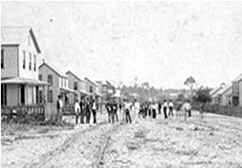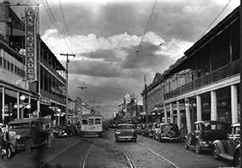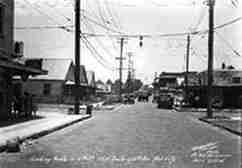History
of
Ybor City
Don
Gavino Guiterrez, a Spanish civil engineer, came to this region
in 1884 in quest of guavas. He hoped to establish a tropical
fruit preserving plant. But, his investigation convinced him
there was insufficient supplies of fruit available to justify
the investment. He abandoned the project, but decided to return
to New York by way of Key West to visit friends there. They
were Don Vicente Martinez Ybor and Don Ignacio Haya, two of
the most prominent cigar makers of the time.
Guiterrez discovered his friends suffered with constant labor
troubles and were considering relocating their factories. Guiterrez
conveyed to them his impressions of the Tampa Bay area and encouraged
them to investigate the area. They did and both were delighted
with what they found. The Tampa Board of Trade offered them
$4,000 in cash and land as an inducement. They decided to move
here. Thousands of acres of land were bought, and plans laid
out for the establishment of Ybor City.
On October 8, 1885, a force of woodcutters moved into the area
and began clearing the wilderness. The first Cuban cigarmakers
arrived in 1886 on the Hutchinson sidewheeler. The village was
located 2 miles east of Tampa. The 2 communities were separated
by thick palmetto scrub.
In 1887, Ybor established a railway connecting Ybor City with
Tampa. "El tren urbano" ran on a schedule of "once in a while."
Other cigar manufacturers were induced to move their factories
to Ybor City. As a result, many plants from Havana, Key West
and the northern United States began to relocate here.
Within 5 years, Ybor City was known as "Little Havana". The
population had grown to 15,000 compared to Tampa's approximate
3,000 citizens. It had become a melting pot for 4 distinct cultures;
Spanish, Cuban, Italian and Florida "Cracker". Even today, many
of its residents are tri-lingual.
In 1887, Ybor City was incorporated into the city of Tampa and
become the 4th district. However, its name and identity was
never lost. Ybor City had its own first stations, social club
houses, Spanish and Italian newspapers. In the late 1880's Italians
from the New Orleans and St. Cloud area began migrating to Ybor
City. Most farmed or established grocery operations before becoming
a part of the cigar industry.
Today, most, if not all the cigar factories are closed. Ybor
City fell into a state of disrepair several years ago. Most
of the natives relocated. The Ybor City of today is not unlike
the French Quarter of New Orleans. Restaurants, bars and artist
studios populate the area. Original architecture is preserved
and protected by the Barrio Latino, Hillsborough County Preservation
Board and Ybor City Chamber of Commerce to name a few.
(Source: Hillsborough Co FLGenWeb Project)

Ybor City 1966
|
 Ybor City
1885
Ybor City
1885
 Ybor City
residences 1885
Ybor City
residences 1885

Ohio
Troops 3rd Camp during
Spanish American War - Ybor City 1889

Ybor City
1920
 12 Ave. &
6th Ybor City 1936
12 Ave. &
6th Ybor City 1936
|








